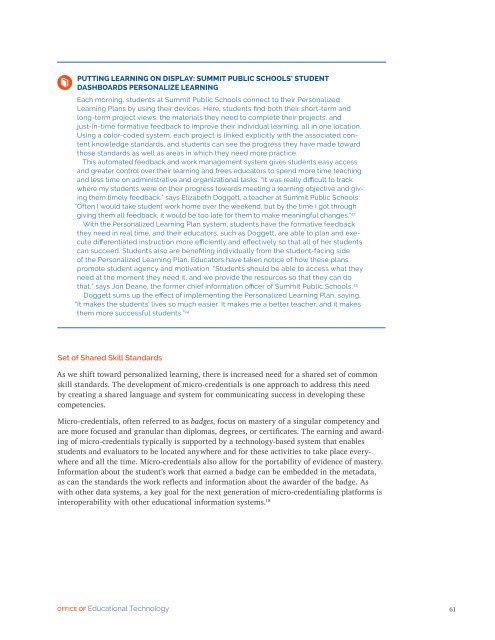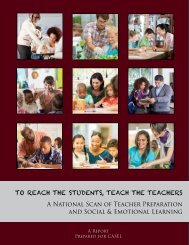Future Ready Learning
7m3sdJ
7m3sdJ
Create successful ePaper yourself
Turn your PDF publications into a flip-book with our unique Google optimized e-Paper software.
PUTTING LEARNING ON DISPLAY: SUMMIT PUBLIC SCHOOLS’ STUDENT<br />
DASHBOARDS PERSONALIZE LEARNING<br />
Each morning, students at Summit Public Schools connect to their Personalized<br />
<strong>Learning</strong> Plans by using their devices. Here, students find both their short-term and<br />
long-term project views, the materials they need to complete their projects, and<br />
just-in-time formative feedback to improve their individual learning, all in one location.<br />
Using a color-coded system, each project is linked explicitly with the associated content<br />
knowledge standards, and students can see the progress they have made toward<br />
those standards as well as areas in which they need more practice.<br />
This automated feedback and work management system gives students easy access<br />
and greater control over their learning and frees educators to spend more time teaching<br />
and less time on administrative and organizational tasks. “It was really difficult to track<br />
where my students were on their progress towards meeting a learning objective and giving<br />
them timely feedback,” says Elizabeth Doggett, a teacher at Summit Public Schools.<br />
“Often I would take student work home over the weekend, but by the time I got through<br />
giving them all feedback, it would be too late for them to make meaningful changes.” 22<br />
With the Personalized <strong>Learning</strong> Plan system, students have the formative feedback<br />
they need in real time, and their educators, such as Doggett, are able to plan and execute<br />
differentiated instruction more efficiently and effectively so that all of her students<br />
can succeed. Students also are benefiting individually from the student-facing side<br />
of the Personalized <strong>Learning</strong> Plan. Educators have taken notice of how these plans<br />
promote student agency and motivation. “Students should be able to access what they<br />
need at the moment they need it, and we provide the resources so that they can do<br />
that,” says Jon Deane, the former chief information officer of Summit Public Schools. 23<br />
Doggett sums up the effect of implementing the Personalized <strong>Learning</strong> Plan, saying,<br />
“It makes the students’ lives so much easier. It makes me a better teacher, and it makes<br />
them more successful students.” 24<br />
Set of Shared Skill Standards<br />
As we shift toward personalized learning, there is increased need for a shared set of common<br />
skill standards. The development of micro-credentials is one approach to address this need<br />
by creating a shared language and system for communicating success in developing these<br />
competencies.<br />
Micro-credentials, often referred to as badges, focus on mastery of a singular competency and<br />
are more focused and granular than diplomas, degrees, or certificates. The earning and awarding<br />
of micro-credentials typically is supported by a technology-based system that enables<br />
students and evaluators to be located anywhere and for these activities to take place everywhere<br />
and all the time. Micro-credentials also allow for the portability of evidence of mastery.<br />
Information about the student’s work that earned a badge can be embedded in the metadata,<br />
as can the standards the work reflects and information about the awarder of the badge. As<br />
with other data systems, a key goal for the next generation of micro-credentialing platforms is<br />
interoperability with other educational information systems. 18<br />
OFFICE OF Educational Technology<br />
61



